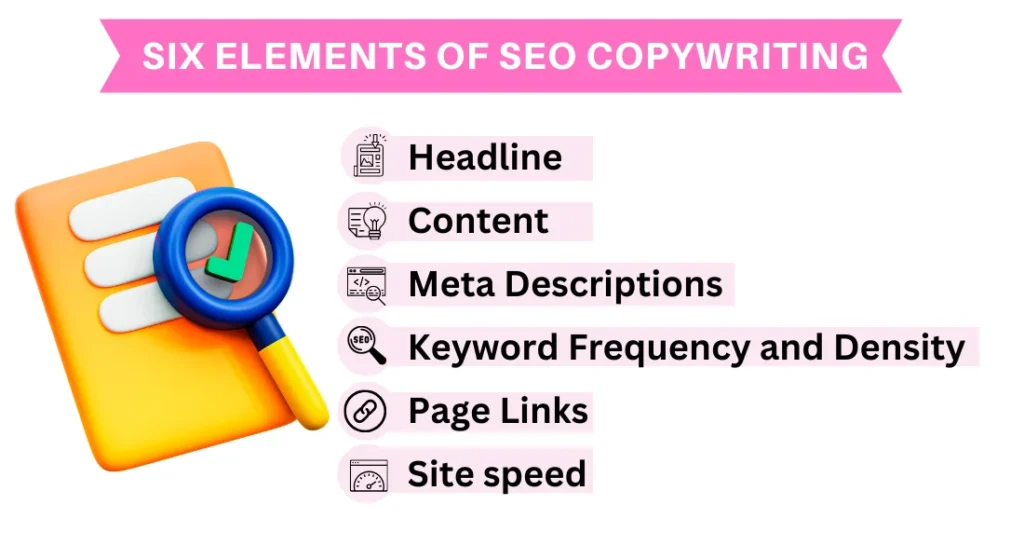15 Best SEO Copywriting Tips To Sky-Rocket Rankings
Copywriting has been around for a long time, with its roots going back to 1477! But the introduction of the internet unlocked the true potential of copywriting, making it a powerful method to reach a global audience and attract unlimited leads at low costs! So, you must apply the best SEO copywriting tricks quickly to ensure that your copies get the attention they deserve.
However, the results of copywriting are fading as the exploding competition makes it increasingly difficult to stand out and get the attention of your target audience. As a result, you must ensure that search engines rank your copies higher in the search results.
And this is where search engine optimization for copywriting comes in!
SEO copywriting combines compelling promotional content with low-cost SEO techniques that rank your copies higher in the search results. This ensures maximum views and conversions without costs that go through the roof!
In fact, SEO is becoming an irreplaceable aspect of copywriting as 53% of organic website traffic comes from web searches alone. Therefore, without robust SEO measures, you will be invisible!
This blog will help you by covering the best tips to apply SEO in copywriting. Let’s get started.
Table of Content
- What Is SEO Copywriting And What Is Its Importance?
- SEO Copywriting Vs. SEO Content Writing
- SEO Copywriting Tips
- 1. Know your audience
- 2. Find the Right Keywords
- 3. Find Questions People Ask
- 4. Speak the language of your target audience
- 5. Be concise and to the point
- 6. Avoid keyword stuffing
- 7. Identify and Map Search Intent
- 8. Check Competitor’s content for Target Keywords
- 9. Gather Original Data
- 10. Optimize Your Meta Title, Meta Description, and Header
- 11. Create Organized and Easy-to-Read Content
- 12. Add Visuals
- 13. Include CTAs
- 14. Focus on the Linking Structure
- 15. Continuous testing
- How Does Copywriting Help With SEO?
- Six Elements Of SEO Copywriting
- Ready To Create Irresistible SEO-Powered Copies?
- FAQs
What Is SEO Copywriting And What Is Its Importance?

SEO copywriting is the practice of writing search engine optimized content that is designed to appeal to both human readers and search engines. It pairs SEO practices that boost online visibility with compelling promotional writing that drives the audience into favorable action. This action could be buying a product, sharing content, or subscribing to an email list.
Here are some examples of content types that you may create with SEO copywriting formulas to boost their ranking on search result pages-
- Final checkout screens
- Product descriptions
- Advertising content
- Website copy
- CTA buttons
- Landing pages
- Brand Messaging
- On-site navigation instructions
SEO copywriting is crucial for the success of your business’s promotional efforts. This is because it takes writing compelling promotional copies on targeted platforms to the next level!
Applying SEO in copywriting ensures that search engines can understand and present it on relevant web searches. And this can make your copies way more effective by ensuring they are visible to the target audience despite your competition.
In fact, copywriting without SEO is no longer a feasible option with the growing competition! This is because non-optimized copies will be lost in the sea of online promotional material. And even the best copies will be useless if your audience does not see them!
SEO Copywriting Vs. SEO Content Writing

SEO copywriting and SEO content writing have the common end goal of converting the target audience into customers. But, they differ significantly in writing style, content, and objectives.
Copies convert leads through brief text, while content writing aims to generate organic traffic and customer engagement through long-form content.
However, the two techniques are closely interrelated and get the best results when used together. But how?
Content writing generates interest and engagement, while copywriting raises the initial awareness and converts the interested audience. For example, you may start with an SEO blog post that gives valuable information to get readers interested. And you can conclude the blog with a CTA created with SEO copywriting to convert the interested readers into customers!
SEO Copywriting Tips

Here are some SEO copywriting tips that will help you create search engine optimized copies that rank high on searches and get targeted traffic, ensuring higher conversions-

1. Know your audience
Copywriting requires you to write persuasive content that your audience can understand and relate to easily. Naturally, this requires you to have a deep understanding of your target audience beforehand.
So, you must start with audience research to understand the key characteristics, lifestyle, needs, desires, and problems of your target audience. Based on this understanding, you must build an imaginary personality or persona that you need to attract and convince through your writing.
This human approach is critical for effective copywriting to capture and compel your audience to convert them into buyers. It also forms the basis for your keyword research by giving you a general idea about the audience you are addressing.
2. Find the Right Keywords
Successfully identifying and targeting the right keywords while keeping search intent in mind is the secret to writing converting SEO copies.
You can use various tools to find the right keywords based on the general topic and competitor content. The keywords should be a mix of short-tail (general) and long-tail (specific) keywords that have low keyword difficulty and high search volume.
3. Find Questions People Ask
Predicting your users’ questions is a great way to optimize your content, as your copies will rank higher in SERPs if they answer the search queries made by your audience accurately.
Here are some SEO tools and methods that can help you find questions relevant to your topic-
- PAA (People Also Ask) box at the bottom of Google search result pages
- AnswerThePublic
- Quora
- Topic Research Tools
Once you identify the most popular questions your audience asks, you must create copies that answer them accurately in a more attractive, persuasive, and informative manner than your competitors. After all, you can’t get someone to part with their hard-earned money unless you address their concerns precisely by answering the questions they ask.
4. Speak the language of your target audience
As an SEO copywriter, you must write in a language your readers can easily understand and relate to, as this can greatly increase your conversion rate. So, you must use the keywords and search terms your audience uses rather than making your own guesses.
For this purpose, you must follow the above points to research your audience, find the questions they ask, and use the right keywords.
5. Be concise and to the point
Your audience has a short attention span which you must target and capture before your competitors take over! So, you must keep your copies short and precise by avoiding long sentences and complex terms. Moreover, you must focus on only the unique features that set your product apart rather than explaining apparent characteristics.
The key is to get your message across to the audience in the most concise yet compelling way possible. And this is where the copywriter’s skill is put to test!
6. Avoid keyword stuffing
Keyword stuffing is the practice of adding keywords excessively in an attempt to improve organic search performance. It is a largely outdated practice that is now considered spamming by search engines like Google. As a result, search engines will drop your SERP rankings if they detect keyword stuffing.
Moreover, stuffing keywords into your copies makes it appear complex and unnatural to your audience. And this lowers its impact on the readers while forming a poor impression of the promoted offering.
So, keyword stuffing is a counter-intuitive practice that you must always avoid as an SEO copywriter.
7. Identify and Map Search Intent
The intent behind the user’s searches varies depending on the stage in the customer journey. So, your keywords and content should also vary based on the specific intent in the awareness, interest, desire, and action stages of the sales funnel. This flexibility will help you match what the customer is looking for, hence raising your SERP ranking, traffic, and conversions.
The search intents you should consider while deciding your content and keywords are of four types-
- Informational: Users want to find information on a specific topic, product, or service. Example- “best photocopy machines.”
- Navigational: Users intend to visit a specific web page. Example- “Xerox photocopy machines.”
- Commercial: Users consider making a purchase and wish to investigate their options. Example- “Xerox photocopy machine comparison.”
- Transactional: Users aim to purchase the product or service. Example- “buy a Xerox photocopy machine online.”
8. Check Competitor’s content for Target Keywords
You can also use various keyword research tools to analyze the search engine results for specific keywords based on your topic. You can also check the top keywords used by competitors and analyze their content for inspiration to write or improve your copies.
Here are some questions that you must ask while analyzing the competitors’ content to draw valuable inferences-
- What keywords are competitors using, and how are they applying them in their content?
- What are the semantically-related keywords in their articles?
- What is their content’s readability score?
- How long and comprehensive is the content of top competitors?
- What outline and formatting are competitors using?
- What is the content and writing style in competing sites?
9. Gather Original Data
Using original data is an effective trick to engage and convince your readers while creating backlink opportunities and building an authentic image. So, you must gather information or statistics about the topic from reliable sources before writing your copy.
While this data can be from secondary sources, it is advisable to use primary sources to get fresh data specific to your purpose. Some reliable original sources are-
- Social media polls
- Your own sales data
- User-generated content
- Primary research
10. Optimize Your Meta Title, Meta Description, and Header
The first thing readers see in SERPs is the page’s meta title and description. If this impresses them and they visit the page, they will see the header, which may encourage them to read further. Moreover, search engine algorithms will also go through these three elements to understand your content and decide its rankings.
So, you must optimize your meta titles, meta descriptions, and headlines to boost your organic click-through rate and also increase page views and conversions. This optimization must focus on impressing both search engines and users. And it includes keeping the meta content and headings short, compelling, keyword optimized, and easily understandable.
11. Create Organized and Easy-to-Read Content
People use search engines to look for quick information or concise answers to specific questions. So, your content must be simple, to-the-point, easily readable, and specially structured for the quick scanning that most readers perform.
You should use the active voice, a conversational tone, and first or second person to enhance readability. Also, you must keep the content concise and logically structured using headings. But it must be comprehensive enough to answer the questions behind the respective searches.
12. Add Visuals
Visuals have a uniquely engaging and persuading power that amplifies the effect of written copies. You can use visual elements like relevant images, infographics, and videos for SEO and readability using alt tags. Moreover, SEO website copywriting using images increases the readers’ interest and time on the page.
These advantages naturally raise the traffic and chances of conversions and sales. But that’s not all! People tend to share visual content that they like on social media. And this increases the reach of your content, making SEO copies ideal for SEO social media marketing.
13. Include CTAs
Copies aim to grab the attention and interest of people with compelling content. But they ultimately aim at converting the interested audience into customers. After all, the primary purpose of copywriting is to drive users further along the sales funnel. And this is where calls to action come in handy!
CTAs give people a convincing reason to take favorable action. This action may be to visit the landing page and make the purchase, sign up for newsletters, or share the copies. CTAs can be hyperlinks, buttons, or images. And they usually include some compelling text that encourages the audience to click on them and proceed along the sales funnel.
Effective CTAs improve your copy’s conversion rate and ROI. They also boost your SEO by improving your page views and decreasing bounce rate, which leads to improved SERP rankings. However, you must use CTAs sparingly while maintaining uniform intervals, so viewers notice your CTAs but don’t get overwhelmed by them.
14. Focus on the Linking Structure
The Google algorithm uses links on web pages to proceed to other pages while indexing every page it finds. It also decides the SERP ranks for every page based on the quality of links on the page or links that brought it to the page (backlinks). Similarly, users judge your site based on its links or the sites with its backlink.
Here, link quality is defined by the authenticity and popularity (authority) of the page on which its link was posted on, and the authority of the pages it links to.
Given the importance of link quality, it is important to use links to authentic external sites while attempting to get links to your content pages on other leading sites. Getting this right will improve your rankings while building trust around your copy.
In addition, users also look for links to find how to progress to the next logical step. So, you must remember to add links to internal pages to guide your audience toward the purchase. And don’t worry if all this looks too technical! You always have the option to use an SEO copywriting service to write and improve high-quality SEO copies.
15. Continuous testing
You must constantly measure and boost your copywriting results with the right tools to ensure that your copies are effective and updated. Some factors that you must consider and improve for this purpose are-
- Click through rate
- Conversion rate
- Opt-in rate
- Likes/Comments/Shares/Feedback
- Traffic volume and type
Apart from these post-publishing metrics, you must also focus on the pre-publishing measures to ensure or improve the quality of your copies. These include considering all the above tips, such as SEO score, alignment with the audience, comparison with competitor content, and readability score.
How Does Copywriting Help With SEO?

Copywriting helps with SEO if you incorporate SEO principles while writing the copies. A copy may include the following SEO measures that will boost its visibility to the target audience-
- Headline optimization
- Page links
- Intent optimization
- Action word usage
- Meta description optimization
- Strategic structuring
- Keyword usage
- Continuous testing
You can apply these SEO copywriting measures to help search engines analyze and rank your copies at high positions in search engine result pages (SERPs). And this will get high-quality traffic to your post, website, or other copies at low costs.
Moreover, SEO copywriting minimizes bounce rates and boosts conversions by ensuring you get targeted traffic. This is because SEO brings you people who did relevant searches and are hence interested in your niche.
As a result, integrating SEO practices into attractive and persuasive copywriting will help boost your marketing copies’ visibility, conversion rates, and ROI.
Six Elements Of SEO Copywriting

Here are the top six critical elements that you must consider while copywriting. Optimizing these six factors is the key to writing the best SEO copies that help you rank high on SERPs by defeating your competition-

1. Headline
Your headline is an essential element of your SEO copy, as a good headline catches people’s attention and compels them to click and read further. In fact, 8 out of 10 people read just the headline in copies! So, here are a few tips that you can use to optimize your headings-
- Include a number in the title.
- Keep your headline short and catchy.
- Use SEO tools to find the right keywords.
- Keep the headline consistent with your brand voice.
- Apply market and audience research for content inspiration.
2. Content
Your copies must deliver high-quality content that gives your audience what they’re looking for. Remember that ignoring users’ search intent to focus only on traditional SEO would not have the desired impact on the audience. Moreover, search engine algorithms are also evolving to prefer copies that address the users’ needs, making it an essential element for SEO.
3. Meta descriptions
Meta descriptions are short texts that describe web pages. Search engines consider them while ranking and they are often read by the audience before clicking its heading in the search results. So, you must create an SEO-optimized meta description by using the right keywords to rank well while attracting your readers’ attention.
4. Keyword frequency and density
Keyword frequency is the number of times your keywords appear on your page, while keyword density is the ratio of your keyword phrase to the total words on the page. You must perform keyword research using the right SEO tools to find the best keywords that attract high traffic but have low competition.
Then, you must use these keywords at the right places in your copy’s text to get the right keyword frequency and density. Make sure not to overdo it, though! As you already know, keyword stuffing is considered spamming by Google.
5. Page links
Adding page links to your copies and links to your copies on other pages will help search engines judge the quality of your content. Google will rank your page higher in SERPs if you add links to authentic resources in your copies or that of genuine and popular sites.
For this purpose, you may request relevant and authentic sites to add your content with do-follow backlinks to relevant pages that have your copies. Here, backlinks refer to the outbound links that take users to your site from other sites.
Further, you may add links to comprehensive guides and resources in your copies by adding hyperlinks to natural-looking text. And these links may also include links to other pages within your website to help search engines recognize your entire site.
6. Site speed
Site speed is indirectly related to the SEO of your copies on the respective sites. And this is because search engine algorithms consider the loading speed of your website as a significant factor while ranking your site.
So, optimizing your website for higher speed and stability will raise its rankings. Moreover, loading speed significantly affects the bounce rate of your website. This is reflected in the fact that 53% of visitors leave a web page if it takes over 3 seconds to load!
Ready To Create Irresistible SEO-Powered Copies?
SEO copywriting is the perfect solution for any business to reach its target audience at little to no extra costs, multiplying its marketing ROI manifold!
All you need to do is integrate these simple SEO tips into your copywriting to boost your copies’ visibility and conversion rates. However, you must also maintain content quality from the human perspective instead of writing purely for search engine algorithms.
Once you get the balance right, the SEO copywriting tips will ensure better visibility of your copies, while the content will ensure that its viewers get impressed and convert into customers. And the combined impact will help you beat your competition in no time!
So, be quick and leverage the power of SEO for your copywriting to skyrocket your rankings, conversions, and profits. SEO copywriting is a low-cost hack to successful marketing that you can’t miss!
All the best!
FAQs

The best SEO copywriting strategy involves using persuasive and data-backed content in a simple, concise, visually appealing way. This must be based on detailed research, keyword analysis, and constant improvement.
You can apply SEO copywriting to your copies to help search engines analyze and rank your copies at high positions in the SERPs. This measure will boost the visibility, conversion rates, and ROI of your marketing copies.
The 9 types of copywriting are-
1. SEO copywriting
2. Product copywriting
3. B2B copywriting
4. B2C copywriting
5. Direct response copywriting
6. Ad copywriting
7. Social media copywriting
8. Creative copywriting
9. SEO Website copywriting

